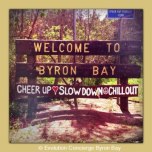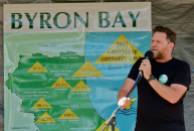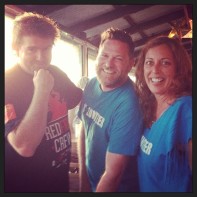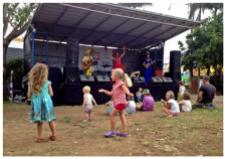My Vision of a Sustainable Shire
With only 15 minutes to share a broad vision of sustainability, lets face it -it could take 15 minutes creating a definition of sustainability, especially within the often pervasive current atmosphere of green wash.
So, I will steer clear of that and will try and consider and capture the one part of sustainability that is rarely considered, the one aspect that underpins Byron’s social, environmental and economic sustainability- it is the energy of the land-its spirit.
The energy of the land is that which we create our community, our environment and our economy upon. It is this that informs the type of community who gravitate here, it is this what ensures that those who work within this energy generally flourish, whilst they who don’t, ultimately leave.
Traditionally, a sustainable model of living within a community was to develop industries that each generation could inherit from the last, generation after generation and each job created to stay in the community.
This is not the natural model of sustainability for Byron.
Traditionally, Byron was a place that was an open, universal space maintained by guardians to keep this essence alive. People came from far and wide to corroboree, to learn and to share culture and celebrate and connect, and then leave. To facilitate this, the Awakwal were the guardians of these special places and meeting grounds. Indeed, this town was named Cavvanbah– the meeting place.
It is that same pulse, that energy within the land that draws us here; and it is the strength of it that ensures we sometimes need to leave the bubble here, because it is so strong.
When considering ‘sustainability’, we should look at thousands of years of a sustainable model to replicate, not an ideal based on models not aligned to where we live.
If we truly wish to be sustainable, perhaps we need to acknowledge this energetic reality about our shire and promote industries, behaviours and public spaces that cater and facilitate this energetic reality.
With Byron, social sustainability is about supporting our community so we can continue being empowered and continue to be guardians of our public space. So, the community, the guardians need to be looked after, whilst ensuring that what we do maintains the rightful, natural environment of Byron as a public space.
Which is why the desire for a sustainable community dictates that holiday letting must still operate within a community context, not just an economic context. We need to ensure that our community stays vibrant, strong and intact so it can hold the guardianship of the public space appropriately.
It is getting that balance right that is the key.
That balance dictates also why social sustainability cannot just be about the lifestyle of the permanent community; our concept of sustainability must also be about what we are giving and maintaining for the rest of the world, so Cavvanbah continues to be a meeting place
Which is why Park and Ride, (which not only will be highly effective if done well, groundbreaking and an example for the nation) also importantly focuses on changing the behavior and environment for the 82% of mainly visitor road users seeking to enter Byron. This must take precedence over the 18% or mainly residents who wish to bypass it, though locals will clearly gain massively also if 82% of cars are off Ewingsdale road.
A globally considered Park and ride that leads to the creation of a pedestrian mall is a natural fit because it is about creating and opening a public space for all of us, for everyone, long term local, short term visitor, to interact come, to congregate, to share, to celebrate, and to leave. It is in keeping of 50,000 of energetic sustainability that is Cavvanbah.
A social sustainability that acknowledges our national and global roles is also why we can’t just close Byron at night just for residents when this decision will affect mainly younger residents and visitors who frequent this public space to meet.
Yet, at the same time, though it is a public space, like for the last 50,000 years, people have come respecting and come expecting to give as much as they would get, and this must continue and as guardians, we must ensure it happens.
We need to ensure people meet sustainably- it is not just an open space for anyone to use and abuse and exploit; it is a place for people to learn, celebrate, strengthen their spirit and take the essence back to where they came from, telling the right types of potential visitors, nationally and overseas and then they in kind, come with this expectation- this allows Byron to create its own orally shared, sustainable, respectful visitor industry.
So economically, what are sustainable industries that can fit inside this model? Some economic areas that fit within this model are education, product development, innovative energy development and niche agricultural industries.
Myself and a few others are currently working on the development of what we are currently calling the Byron Precinct for Global Solutions.
Here, Byron Shire will be a major contributor to the solutions we need to meet the global challenges that are facing us. We will have compelling world-class education and research facilities and a R&D incubator that provides a globally recognised pathway into the world of applied sustainability solutions. Thus, environmental sustainability will come from what we learn and apply as much as what we save and protect. It is focused on engineering a future for our kids here in Byron Shire, giving them skills that they may use and practice whilst they stay in the shire, or just as importantly, leave and share with the world. Education of our youth should not just be so they stay in the shire, generation after generation, no, it should be to make them global citizens of the highest order.
The precinct will be a place where great minds and great doers have a home. Through the development of an educational precinct in Byron Bay, focusing on adaptation, resilience and design, the project intends to provide 3.26 hectares of Council-owned land, at Bayshore Drive, Byron Bay , attracting university, private, philanthropic, public and public-agency investment, with a strong, independent, precinct governing body. A stewards ship ‘guardian ‘panel if you will.
Niche agricultural innovations are also easy sustainable fits within our future. Permaculture is an example of locals creating spaces for both locals and global visitors to come, learn, apply skills and then leave. Our residents either take these skills back their land locally increasing farming viability or they take the skills and sharing them with the world. Using our expensive, but incredibly fertile land can be used to develop niche, globally important crops and agricultural products- this exists now and should be continually supported.
In the energy sector, council is committed to not just creating financially viable solar projects of significant scale, but doing so within a cooperative model with our community, because it is important to empower our community, it provides financially sustainability to our wider community, and also helps create that model for the rest of the country, the rise of solar energy is a highly democratic development and is the anti-thesis to a centralised black energy future. Byron Shire is home to a number of experts in renewable energy and a vision that marries communication, transport, and energy with a creative edge has a good chance of being successful here.
Developing large solar projects also allows our home grown industry to increase their capacity and whether they end up working further afield than from our shores, we have allowed them to grow their business so that they become national and global players. Not just keeping their skills and their vision within the shire boundaries, which again, was the traditional method.
The creative industry is the perfect economic fit for our Shire. It is based on innovation, it is global, it is moveable and adaptable and it does not require a huge environmental footprint. So many of our hundreds of creatives live here, work both here and around the world and are multi-skilled- this is a sustainable industry that is already organically thriving, and this indicates how a natural sustainable fit it is within our shire. Further developing a ‘Silicon Bay’ concept is potentially a perfect fit with Council playing a role in encouraging tech businesses to locate here or have a link to this area. Employment could be encouraged across a range of jobs ranging from trades training to energy finance to waste management, sustainable housing.
Concerning this concept of supporting creative industries, it is crucial that they are supported, because ultimately, if we cannot create fluid, ongoing, viable, invigorating, innovative and nationally and globally important positions and jobs within this shire we will ultimately become a shire of retirees and visitors, perhaps like Ballina, albeit richer. Truly to have the next generation of community and guardians living here they need work that can allow them to move, to stay, to innovate, to learn from the world and to teach the world.
Ultimately, Sustainability is not just working with the land, the economy and community – it is understanding the energy of the land which informs the spirit of the community, who in turn, informs the economic models that support the land and community.
If we look at past experiences where arguably our community’s came unstuck, it was those decades focused on one industry, focused on mainly only the permanent community, focused on finite occupations like whaling, or logging or diary, neither socially, economically and environmentally sustainable. We must learn from these times to ensure our communities can meet the challenges of the world and indeed, be apart of the solutions to the challenges of our world.
Because it was when we were in economic and environmental ruins, it was that new wave of creative thinkers, creative doers and those environmentally alert that resuscitated the town; and interestingly it was an event (the Aquarius Festival), for people coming, sharing, learning and teaching before predominately going that again- brought the area back to life. The alternative culture that came here brought an alternative awareness, brought a commitment to community and importantly, brought social and cultural investment that we can now rely on, though never take for granted. We learnt from this wave of modern day ancients- that, by all of us potentially having a little less so collectively we have more, we become truly sustainable.
Aspects such as park and ride, pedestrianising our spaces, acknowledging that many within our community move, create and travel, creating educational and product development spaces, being innovative, these things feel natural here, they resonate here, they make sense here, it is important we acknowledge what is real and genuine in our area, fighting and resisting it is not sustainable. Being sustainable is about not just how we work, live and move on our land- it is listening to it, learning from it, welcoming others on it and being guardians of it.




























































































































































